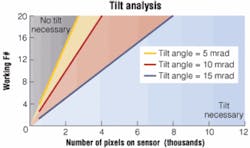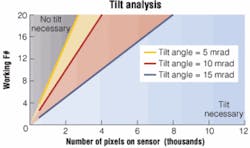Large-format-imager standard proposed
Andrew Wilson, Editor, [email protected]
At this year’s International Robots & Vision Show, Edmund Industrial Optics (Barrington, NJ, USA; www.edmundoptics.com) proposed developing a standard to alleviate the problem of aligning high-resolution linescan and area-array cameras with large-format lenses. In a presentation to a group of invited sensor, lens, and camera manufacturers, Samuel Sadoulet, director of product development at Edmund, outlined the problems faced by system integrators.
“Applications such as flat-panel inspection,” he says, “are dictating the need to deploy cameras with increased resolution. At the same time, the high throughput of such systems is demanding faster optics and increased signal-to-noise ratios of the cameras. With these demands, the system integrator is presented with a mechanical hurdle when mounting very-large-format CCD and CMOS linescan and area-array cameras to fast lenses.”
This problem is relatively new. In January 2005, for example, Schneider Kreuznach (Bad Kreuznach, Germany; www.schneider-kreuznach.com) introduced a lens/camera mount to enable simple, precise lens-to-CCD alignment with the CCD-based Piranha3 12k linescan camera from Dalsa (Waterloo, ON, Canada; www.dalsa.com). “Achieving such true alignment can be virtually impossible with ordinary mounts because of the sheer size and often difficult placement of the CCDs found in large linescan cameras,” says Stuart Singer, vice president of industrial optics at Schneider Optics USA (Hauppauge, NY, USA; www.schneideroptics.com). Because the lens mount was built specifically to interface Schneider’s 5.6/120-mm linescan lenses with the Dalsa camera, other lens and camera manufacturers could not make use of the technology.
“Whether such a lens mount should be used,” says Edmund’s Sadoulet, “is directly related to the number of pixels in the imager and the aperture of the lens (see figure). Using a 4k × 1 CCD-based camera with a very small aperture of f/16 may not require a specialized mount since the depth of focus will be large. However, when these cameras are used with faster f/2 lenses, the depth of focus will be smaller, and there is a requirement to properly align the image sensor and the optics plane. In his presentation, Sadoulet proposed a standard mount that would accommodate 2-12k × 1-based cameras and remove the burden of aligning optics and imagers by use of a standard mount.
Accommodating both pitch and yaw, the proposed standard would use a tilt mechanism centered around the imager’s center pixel and accommodate C-mount through 100-mm sensor size. “By developing such a central tilt mechanism,” says Sadoulet, “system integrators will be able to take full advantage of the performance of the sensor and the optics. Better still, because depth of focus will no longer pose a concern, this will result in increased light throughput of the imaging system. Settling on a few such interfaces could easily cover the range of cameras and lenses currently available,” Sadoulet adds. Says John Stack, president of Edmund Optics, “Standardizing the mechanical interface provides long-term benefits to the whole vision community, from the camera manufacturers to the system integrators. Our hope is that this conversation will be the genesis for a new Automated Imaging Association (Ann Arbor, MI, USA; www.machinevisiononline.org) standard and ultimately provide a forum for international input.

